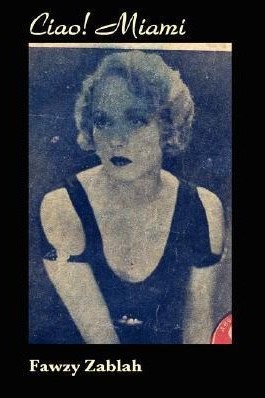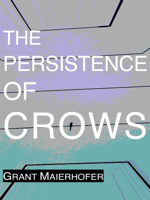
Self-published under the moniker Little Havana Press in 2006, Fawzy Zablah’s collection of stories, Ciao! Miami, is a thrilling, inspiring book, one which explodes passionately from page one with a zeal for life. Regardless of length, each story unfolds its complexities at stiltedly strange but intuitively correct intervals. The resulting narrative structures, perhaps best described as smoothly stilted, is one which belongs wholly to Zablah, who proves himself to be a natural-born fiction writer. Each of the main characters in Ciao! Miami’s nine stories develop intriguing complexities throughout the telling of their tale. Zablah has carefully crafted these characters, similar to the way in which one crafts an origami tiger out of a printed image of a tiger in the jungle. This careful crafting is a sign of Zablah’s writerly talent at observing and recording who people are and how they behave; furthermore, his precise storytelling is equally factored into why reading Zablah’s fiction is both enjoyable and fulfilling. The stories of Ciao! Miami are so masterfully written with passion and intensity that, like true inspiration, the reader experiences in Fawzy Zablah the desire, the urge, to write one’s own story, inspired by good art to likewise create good art. Individually, each story is a compact ball of energy, crackling with life, with Zablah’s labor and love; however, even if a character fizzles out, the story itself succeeds, bursting brightly and memorably in the reader’s consciousness. But taken as a whole, Fawzy Zablah’s deeply talented Ciao! Miami, a kaleidoscopic fireworks performance, explodes remarkably and vibrantly through Zablah’s talented writing, through his various and varying characters, storylines, narrative voices, subject matters, and word craftsmanship.
In the beginning of Fawzy Zablah’s collection, there is “Eve in a Blue Robe,” a story which unfolds as delicately and intentionally as the petals of a blooming rose. The titular robe, which conjures illusions to David Lynch’s Blue Velvet, matches the color of the soiled couch upon which Eve languidly awaits the arrival of a gentleman caller, Mr. Luis Capote, who was informed of Eve’s attractive “ho”-ness by his cousin, Tony, who had previously visited Eve’s apartment in an attempt to clean the aforementioned soiled couch. Tony’s attempt at cleaning the couch is in vain, representing the less than true intentions of his passing along Eve’s number to Luis, for Eve, while watching TV before the start of her date, seems depressed, as though she may suspect something ingenuous is afoot. But it is after Eve’s friend Lisa arrives to help Eve prepare for the date when the reader first witnesses Zablah’s masterful craftsmanship, interweaving character backgrounds, conversations, confessions, revelations, and secrets. In less than ten pages, Zablah develops Eve into a strikingly real person by utilizing a staccato narrative style and by whittling sentences into precise and emotional artifacts. When slimy Tony meets Eve and immediately sizes her up as a suitable sexual candidate for his equally slimy cousin, he doesn’t just leer at the woman in her blue robe; rather, Tony “flirted with Eve as if walking at the edge of a pool with no intent of jumping in” (p. 1). Though the two male cousins are inarguably lecherous, Eve is far from naïve: observant and perceptive, Eve knows who Tony is when he arrives and knows of his wealthy cousin and, when offered a date with Luis, she also knows that this might be her one shot at financial security. This complexing of the story and the characters is the well-crafted result of Zablah’s distinctive knack for producing extremely seductive fiction.
Each of Ciao! Miami’s nine stories portray three-dimensional characters, each of whom is steeped within ambiguous complexity, which is Zablah’s distinctive quality of nobly asking the reading audience to actively engage with the stories. One story which is a prime example of this delicious character complexity is “Post-Bug Billy Flint,” a story concerning the wayward, titular young man just before and after he contracts HIV, commonly known as “the bug.” Billy, since coming into his own during puberty, has always possessed the goal of sleeping with many woman, but, after contracting “the bug” from a brief relationship, Billy plummets into depression and despair, believing, essentially, that his life is over since his goal could no longer be fulfilled. Added to this, most of the people he had known abandon him, but Larissa, an old high school acquaintance who had a crush on Billy, immediately came to his aid when he broke down in her arms during a chance meeting in a drug store. At Larissa’s house, she introduces him to her obesely bed-bound mother, a scene reminiscent of a gentleman caller meeting for the first time his date’s parents for approval, and brings him to her room for some awkward conversation, all of which serve to make Billy feel “like a walking regret;” however, Billy “would rather die in an instant than be a walking regret” (p. 13). With mounting momentum, the story’s plot crescendos to a climax, leaving Billy, Larissa, and her mother in a limbo that the reader must decipher and interpret. Perhaps even more intriguing, however, is Fawzy Zablah’s acute attention to detail in “Post-Bug Billy Flint,” as well as many of the other stories, particularly with regard to the Latin-American/Hispanic melting pot which is Miami, FL; for example, when the two young people later sneak into the mother’s room, she awakens and sleepily identifies Billy as “Cuauhtémoc” (the last ruler of the Aztecs, whose subsequent defeat has come to be historically symbolic of the loss of the Aztec’s entire civilization and culture). In this case of mistaken signification, Zablah is signaling something important when the religious-minded mother identifies an HIV+ member of the next generation as the famed fallen leader of the legendary Aztecs.
Even in stories where little of this “meta”-quality exists, such as “Juanito Valenzuela’s Crack Rock” and “We are all Covered with Isa,” Fawzy Zablah still manages to create within the reader an emotional response or recognition-of-self for the character(s) of the story. In “Juanito Valenzuela’s Crack Rocks,” a story delightfully more dialogue than not, the main character, Benny, converses and reflects with other characters on the recent misfortune of the titular character. Juanito’s absence looms over Benny and the other characters like an ominous presence, a foreboding warning which is just beginning to enter the edges of Benny’s peripheral consciousness. By the end of this story, as Benny slips into and then rises out of a night-long drug-addled meditation session on Juanito (p. 21), Benny’s drug habits have lulled him into a false comfort, a belief which, considering Juanito’s fate, increasingly seems to be false both for Benny and his friends. Likewise, in “We are all Covered with Isa,” the titular main character of the collection’s final story also puts himself into situations and performs actions which create the illusion of comfort, but are sadly lacking in truly fulfilling the emotional and mental need of finding and experiencing comfort. Isa’s story is structurally affixed as the final story, which is appropriate because Zablah’s narrative pacing parallels the emotional journey of Isa’s mindset: it fizzles away broodingly like a bomb’s lit fuse. While Isa seeks human interaction and love by dishonest means, he becomes increasingly withdrawn within his thoughts, ironically contemplating what he would do if, by contracting a sexual disease, he were to lose the ability to experience love or connection with another human being. Isa fantasizes that, if this were to happen, his bitterness and anger toward everyone would grow into a bomb which would eventually explode, scattering Isa’s depression “all over the city of Miami” (p. 97). Alienated and already living a life devoid of his longed-for love or human connection, Isa’s fantasy may be closer to reality than he thinks, as evidenced by his lackluster response to helping his injured father, who is his only relative in Miami.
Zablah’s longest story in Ciao! Miami is “The Women’s Army,” a uniquely structured sprawling epic which touches on dozens of topics and themes, from friendship to isolation, from religion, nationality, and philosophy to mental stability, the police state, and action. The two main characters of “The Women’s Army” are Sally and Jack, two strangers brought together either by chance or fate, two individuals spurned into action by the loneliness of experiencing pain. For Sally, living in the victim position of an abusive marriage, she reaches out in desperation to Miami society at large by placing a personal advert in a newspaper, seeking advice and companionship from a strong, yet compassionate male; for Jack, it is the advent of a nervous breakdown, during which he gestates away from society for nine months before receiving a revelation from God/St. Michael the Archangel and, now aware of life’s mechanisms and meanings, he responds to Sally’s plea for help. Jack, as can be surmised, is probably not in a right state of mind, which can happen when one suffers a nervous breakdown without seeking help and is self-isolated from society for such a long amount of time: 9 months, which is the same length of time as human pregnancy, a detail which is unlikely to be an accident, given Fawzy Zablah’s close attention to detail. At any rate, it is quite probable that Jack will have regarded this amount of time as a sign, one which proves that he has, indeed, been visited by God/Archangel Michael. With this knowledge, as well as the information these visions bestowed upon him, Jack responds to Sally’s request for help and meets with her, believing this to be the quest and purpose he was prescribed by the visions. Structurally, “The Women’s Army” is unique amongst Zablah’s stories, for it begins, not with description, but with Sally’s personal ad before jumping radically, exquisitely into the middle of Jack and Sally’s conversation during their first meeting in a restaurant. Shortly thereafter, Jack solves Sally’s spousal abuse problem and, from prison, writes four letters to Sally, which is the second structural joy of this story: the reader is not explicitly “shown” Jack’s time in prison, but told about Jack’s time in prison via Jack himself in the form of these four letters. It is during these letters that the reader learns of Jack’s hostile cellmate (“Easy Robinson” [letter 1, p. 24]), of Jack’s continued delusions, and of Jack’s claim that, though he was sexually assaulted and mocked for his beliefs, Archangel Michael provided Jack the knowledge of his ultimate purpose and the fate of humanity: “a radiant golden figure rose up from the ground. It was the Archangel Michael! He…gave me a revelation!” (letter 3, p. 26).
After Jack’s four letters to Sally, which offer an intriguing, candid glimpse into Jack’s psyche and perspective, the remainder of “The Women’s Army” structurally jumps back and forth in narrative between Jack, who manages to escape prison, and Sally, who is worried about Jack and what he might do. She seeks comfort from her friend, Madame Erika, particularly when they see on the news that Jack has escaped. For Jack’s part, as we have learned from his letters, his ordained mission is to find a Cuban refugee boy in Miami and kill him, since Jack’s Archangel Michael told him that this boy is the anti-Christ and will raise an army of women in Miami to bring about Armageddon, the end of the world. Sally, knowing these plans from the letters, arms herself along with Madame Erika and the two of them seek out the boy’s home to protect him from Jack; there, they join a vigil outside of the house where the boy is staying with family. This storyline of the Cuban refugee boy is not merely a subplot or the end-goal of Jack; rather, this is an example of Fawzy Zablah’s intelligent writing and attention to detail because, in case it is unknown or forgotten, this subplot is based on a real-life event. For the past several decades, there was a general rule of law that, those fleeing Cuba to seek asylum in the United States could do so if they had arrived on shore, but if they were caught by the Cuban government or the United States’ government in the ocean between the two nations, those individuals would be returned to Cuba. Considering this general rule of law, in 1999, a woman (Elizabeth Brotons Rodríguez), her boyfriend, and her son (Elián González) attempted the uncertain journey by raft between Cuba and Florida. The mother died at sea, but Elián survived and was initially placed with maternal relatives living in Miami; however, his father, who was divorced from Rodríguez, petitioned to have his son returned to Cuba. This controversy resulted in numerous American court hearings, polarized the public and political figures, and ended in Elián being extracted by Border Patrol agents who raided the house where Elián was staying on Easter Eve while those who supported his staying in America held a vigil outside of the house. These events, as well as the legal, moral, and national implications surrounding these events, are difficult to contemplate or find an easy solution to, but Fawzy Zablah does not shy away from difficult situations, conversations, and real-life implications, instead being a contemplative author of the true and important. Although the use of this true-life, city-defining event in Miami is seamlessly woven into the fabric of “The Women’s Army” and serves as the story’s climax, some of the story’s most intriguing and chilling scenes occur during Jack’s journey to and throughout Miami. During this Florida-odyssey, Jack encounters a convenience store clerk, a young woman recently graduated from college, a drug-addicted prostitute named Jessica whom Jack had been involved with before his mental breakdown, two of her gay friends at a Miami club on the night before Easter, and a drag queen named Rhonda inside the club. While the two main characters of this story are Jack and Sally, the emotional and consciousness-changing journey in “The Women’s Army” belongs to Jack, who writes in a fifth, story-closing letter that he desires to “bring hope into the lives of people with no hope” (letter 5, p. 53). And if it seems as though too much information has been given away, be assured that that is far from the truth: most of the pleasure in reading “The Women’s Army” comes during the latter half, where the reader witnesses both Jack and the story evolve in Zablah’s skilled hands.
Perhaps no story in Ciao! Miami is as entertaining to come across as the structurally centered “The Last Club on Earth,” which is narrated from the perspective of Rhonda, a seven-foot drag queen wearing loud wigs and louder clothing. In several of the stories leading up to “The Last Club on Earth,” Rhonda has either been mentioned in conversation or has herself made a brief appearance. Original and fascinating, Rhonda’s first appearance in Zablah’s collection is during a conversation between Eve and Lisa in “Eve in a Blue Robe;” later, Rhonda makes an appearance as the aforementioned drag queen from the club scene in “The Women’s Army,” during which she speaks amusedly with Jack about God, life, reality, and the struggle for the soul. Having seen Rhonda in previous stories, it is therefore exciting to find that Rhonda finally gets a story of her own, and the reader is not disappointed. While “The Last Club on Earth” is not about Rhonda per se, the story is told from her perspective, through which Rhonda is able to paint a deeper portrait of who she is and what she believes about reality than how she has heretofore been portrayed in previous stories. In Rhonda’s story, Rhonda and some friends party through the city on what seems to be a crazy but typical night fueled by drugs and alcohol, as well as raising hell, being kicked out of bars, and tricking old, horny drunks into discovering Rhonda’s secret genitals. Bumping into a glum drag queen friend named Mary and partying with her for a while, they finally ask what’s wrong; Mary, in turn, explains her boyfriend, Jesus, won’t wake up, so the girls pile into a cab and get to Mary and Jesus’, where they find Jesus’ body. Mary is in denial, apparently deeply in love with Jesus, and weeps the way Rhonda has “always wanted to cry. Sometimes, I want to fill oceans with my tears” (p. 58). Despite the beautiful similes, Fawzy Zablah manages to craft two distinct but three-dimensional characters in “The Last Club on Earth”—Mary and Rhonda. Mary is emotional and loving, dependent on the need to love and be loved, and latches onto the first, scummy guys who come along and woo her with a bit of attention. Rhonda diagnoses: Mary “always fell hard in love like she will never love again. She has that desperate love” (p. 59). Conversely, Rhonda, evidenced from previous stories and now learning of her mode of thought from her own story, is too tough and level-headed to waste time being sensitive and affectionate because she’s been through shit and, as a result, refuses to take shit from anyone, strangers and lovers alike. However, after the incident with Mary and Jesus and witnessing the aftermath, Rhonda admits to disliking change, perhaps because she has witnessed enough atrocities throughout her own life. But by the end of “The Last Club on Earth,” everything is changing for Rhonda and her perspective of Miami, and her confession is a fitting final sentiment for her story, since it is the structural center of Ciao! Miami and, throughout the remaining stories of Zablah’s realistically heightened book, Rhonda is no longer present, standing tall and proud as a peripheral character to comfort and guide the reader.
Yet Rhonda is far from the only distinct character throughout Fawzy Zablah’s collection; indeed, every main character throughout these nine stories is distinct and crafted with the skilled passion of a true artist. Each story serves, among the aforementioned functions, as a character study of an intriguing individual. Zablah’s character-craftsmanship is noticeably evidenced in both of the desperate characters of the short stories following Rhonda’s: “The Existence of Nabil” and “People Clash in Pre-Smoking Ban Florida.” In the first of these stories, the titular character, Nabil, is a busboy immigrant from Egypt, having traveled to Miami a couple of months before 9/11 to study civil engineering at the Florida International University; however, his role as a busboy takes precedence, within both the story and Nabil’s mind. Intelligently, Zablah wrote Nabil’s story in the third-person limited narrative voice. This choice is stylistically correct for Nabil’s story because, as the reader learns about him, his past, and his life’s ambitions, Nabil’s main protagonist is his own self-consciousness with regard to whether he is viewed by the restaurant’s patrons and employees as an individual human being or merely an object from a foreign (and possibly hostile) culture. Nabil’s Keffiyeh becomes a focal point for his increasingly paranoid suspicion, an obsession which eventually erodes Nabil’s human identity. His self-consciousness regarding his appearance in post-9/11 American society increases and fixates upon his cultural garment: “Is my Kafiyyeh showing Nabil asked [of] himself again. You should run and hide and dispose of your Kafiyyeh! I do not want to run or hide my Kafiyyeh, but I should” (p. 62). Dogged by rude coworkers and treated like a suspicious servant by patrons, Nabil’s perception of the patrons’ perceptions of himself force Nabil into cognitive self-defense such that, during a mental breakdown in the dining room, Nabil identifies, not with himself, but with the culturally symbolic Keffiyeh. In the next story, “People Clash in Pre-Smoking Ban Florida,” we find out that one of Nabil’s coworkers is Sarah, a timid young woman who has run away from a past of neglect and poor treatment. Sarah’s story takes place, presumably, before Nabil’s, but the restaurant is the same: filled with rash employees and presumptuous patrons. Two of the patrons Sarah must wait on are a young woman with a baby carrier and the young woman’s mother, both of whom smoke cigarettes, which Sarah and her coworkers find inappropriate, given the smoke’s proximity to the sleeping baby. Encouraged by her coworkers, Sarah musters just enough gall to ask the women questions, hoping to find a tactful way to address this issue, but in so doing, she discovers that the baby, coincidentally, is also named Sarah. When Sarah does try to inform the women that their habit is, you know, probably not a good thing for Baby Sarah, the mother of Baby Sarah’s mother responds, “go see if the rest of our food is ready…That ain’t your child, so run along” (p. 70). Sarah, upset from the situation’s confrontation, which recalls to her mind memories of her negligent mother and her grade school bully, snaps into action, deciding to do what she can to help Baby Sarah. It is a moment eerily reminiscent of the increasingly paranoid momentum which led to Nabil’s breakdown, such that both stories are told with such raw truth and mounting chaos that it would be hard to believe if Zablah himself has never had first-hand experience working within the food industry.
The second longest story in Fawzy Zablah’s Ciao! Miami is “Darling, It Was an Uphill Battle Loving You,” which is a dark and gritty study of two codependent individuals: a dirt-poor, divorcee narrator named John and the equally dirt-poor, crack-addict prostitute he falls in love with named Soledad. Zablah’s attention to detail never falters in a single story, a fact which remains true here because those two names were not picked by chance. John, though seeming generic at first, is also the term for a hooker’s customer, which is how John and Soledad meet, while Soledad’s name, she explains to John when he asks, is Spanish for “solitude,” a fateful fact with increasing significance as Zablah’s dark romance evolves. Furthermore, John is traditionally considered to be the author of the New Testament’s last canonical gospel, who is also often referred to as John the Evangelist, given the thematic and stylistic nature of his gospel; additionally, John is also the traditional name given to the author of the New Testament’s final book, the Book of Revelation. John’s name is well-bestowed, given that “Darling, It Was an Uphill Battle Loving You” is John’s testimony to the new life he lived post-divorce, the new life he gained upon relocating to Miami. For Soledad, she has lived a difficult, lonely life, one which has deposited her within a crack house, addicted to drugs and turning to prostitution whenever she needs money to buy more drugs. After the two have sex and smoke a bit of crack, John, like the Evangelist, falls in love with Soledad and decides to save her after experiencing for the first time in his life true compassion and love for another human being, but: “The first idea that popped into my mind after that very free verse moment was that I couldn’t possibly save this girl until I had some cash money” (p. 75). Fawzy Zablah’s craftsmanship with regard to character and style is very highly skilled, especially in “Darling, It Was an Uphill Battle Loving You,” wherein John’s distinctive voice is, perhaps, matched only by Rhonda’s. And it is during this chance or fateful encounter between the two characters that John’s quest begins, not only to save Soledad, but to slowly pick up the pieces of himself, for it must be remembered throughout Zablah’s gritty love affair that John, too, is broken, both for lacking full compassion or love for other people, including his ex-wife and his children, and for having lost everything in the aforementioned divorce which brought him to Miami to begin anew. Yet it simply isn’t as easy as snapping one’s fingers, and Zablah gives the reader a realistic climb out of darkness by showing how John must work hard for little pay at a car wash while his home-life doesn’t fare so well, either. Soledad’s climb upward out of her darkness is equally arduous, since she continues to use, often buying crack instead of food with the grocery money John gives her, and when money is lacking, she begs, pleads, yells, or fucks (either John or other johns) for more money for more crack. On those occasions when she does go out to sell her body for money to fuel her habit, acquaintances will inform John of her actions, telling him he should give up on her, that a woman like Soledad is and always will be a crack whore, that there is no saving her. “They told me about her eyes and how they wouldn’t recognize love ever and how I was wasting my time” (p. 77). More than a beautiful passage of desperation and realization, Zablah’s details in this story rely heavily upon eye imagery to reveal something deeper within a character than John’s mere telling of his tale. In this instance, Soledad’s eyes are empty pool drains through which her spirit has swirled away which, when coupled with the knowledge of the meaning of Soledad’s name, produces an epiphany for John: “I just didn’t listen. I didn’t listen” (p. 77).
Like early life’s struggling fight for a lasting foothold, John and Soledad’s relationship, as stated above, is difficult, harsh, and brutish; nevertheless, within a few months’ time, John manages to save enough money to move them out of the crack house and into an apartment, befriends a coworker with whom he spends a good chunk of time each week, and climbs the career ladder to become the manager of the car wash. It is during this time that John receives a piece of candy from an actual evangelical which promotes salvation from drugs via rehab, which John decides may be the next step to saving Soledad from her addictions. Over time and despite a few wagon-falling episodes, Soledad slowly works hard at completing the church’s rehab program with great personal effort and encouragement from John. The head of this church and its rehab is Reverend Houston Carter Johnson III, in whose name appears another “John,” although, in this instance, the Reverend’s “John” is obscured and, therefore, his intentions in helping people break addition is less pure than the intention behind narrator-John’s, which is defined by love and compassion. This fact may be helpful to keep in mind, since a possible symptom of this less-than-honorable approach may be the fact that, during her slow progress toward finishing this rehab program, Soledad begins a job at a cheap, grungy strip club, which John interprets as a positive step forward for Soledad and doesn’t seem to begrudge her for working as a stripper so long as she does so free of drugs. Shortly thereafter, Soledad graduates rehab and begins working at a noticeably nicer strip club than the first; however, a new character enters their lives, Octavios, the owner of this second strip club and employer of Soledad. One night when John arrives at the club to pick up Soledad, he and Octavios accidentally bump into each other, resulting in an intense stare-down between the two men. Octavios finally smirks and walks off, flashing a gun to show his superiority, but the hostility between them lingers, bubbling up from time to time as Octavios seeks to insert himself forcefully into Soledad’s life, shamelessly flirting with her in front of John in order to further assert his superior power over John. Octavios’ introduction into the story threatens the relationship between John and Soledad, but there is another moment which signals the tolling of doom. Shortly after the men bump heads, John and Soledad make love, but it’s description is made to sound forced and routine, while the melancholy sounds of an ending television show signify the end of something else. Afterward, John, who fell in love with Soledad while looking into her eyes, now uses another sense: he listens to her heartbeat, which sounds to John “like a boat sinking and waves crashing” (p. 82). This is the final time John and Soledad are to be intimate together in a truly intimate way, pure and in love. While there is still plenty of story to tell in Ciao! Miami’s second longest story, perhaps the most intriguing aspect of “Darling, It Was an Uphill Battle Loving You” is the ending, which showcases Fawzy Zablah’s mastery of ambiguity. Throughout John’s story is the development of a human being, who falls in love for the first time in his life, experiences the trials and tribulations of that love, and comes to question who he is both to himself and to others; in other words, after the ominous love-making, John experiences his first (perhaps his only) ‘dark night of the soul’ in the latter half of the story. The outcome of the ménage à trois is a supremely violent rush, but pales in comparison to the story’s breathtaking last act, wherein John and Soledad share a final, candid conversation and symbolic act before Soledad returns to work the room and the stripper pole with a show-stopping finale. It is a tender, startling, ambiguous scene which lingers in the mind, raising more questions for the reader to ponder than any of the other stories in Zablah’s fascinating collection.
In Ciao! Miami, Fawzy Zablah distinguishes himself as a master storyteller and an author working skillfully with several literary tools at his disposal. First, of course, is the types of stories Zablah fashions: each story is unique, fresh, and seductive, warmly inviting the reader into the world of the story with ease and purity, which can be the hardest feat to achieve as a fiction writer. Second, his character craftsmanship succeeds at constructing individuals who are distinct and relatable; the reader cares for Zablah’s characters, cheers them on when the going gets tough, and feels the pangs of defeat when they are trampled by circumstance. Whether Rhonda or Billy Flint, Jack or Eve, every character in these stories is vibrant and alive. Another skill Zablah possesses is the wise use of differing narrative voices for different stories and characters, which is a calculated accomplishment; whether using the first-person for “Darling, It Was an Uphill Battle Loving You” or third-person limited in “The Existence of Nabil,” Zablah intuitively knows which narrative voice best suits which character and story. Another deeply rewarding aspect of Ciao! Miami is Zablah’s careful attention to detail, such as the incorporation of history, literature, recent events, and/or pop culture, which helps to develop the characters into relatable individuals and the stories into enriching experiences. Lastly, of course, is Zablah’s passion for writing, the great labor and love he has woven into each tale; it is a passion which runs throughout and exudes from each of the nine stories comprising this remarkable collection. Thus, when these aspects coalesce into a unified whole, the rewards are deep, for Zablah proves his adept storytelling time and again, thereby richly expanding the reader’s consciousness. To delve into the world of Fawzy Zablah’s Ciao! Miami is, therefore, a worthwhile experience, one which will leave a blazing, unforgettable impression upon the mind of any lucky soul who reads a copy of this fascinating book.
 AUTHOR BIO:: dom schwab is a reader/writer of poetry/prose. dom is gay, GQ w/ no pronoun preference, a vegetarian, and lives in Chicago. dom’s most recent work has appeared in Zoomoozophone Review’s female/non-gender-conforming Issue 5, Boscombe Revolution Issue 3: Revolution & Gender, and JunkYard Kool, an anthology presented by Kool Kids Press.
AUTHOR BIO:: dom schwab is a reader/writer of poetry/prose. dom is gay, GQ w/ no pronoun preference, a vegetarian, and lives in Chicago. dom’s most recent work has appeared in Zoomoozophone Review’s female/non-gender-conforming Issue 5, Boscombe Revolution Issue 3: Revolution & Gender, and JunkYard Kool, an anthology presented by Kool Kids Press.








